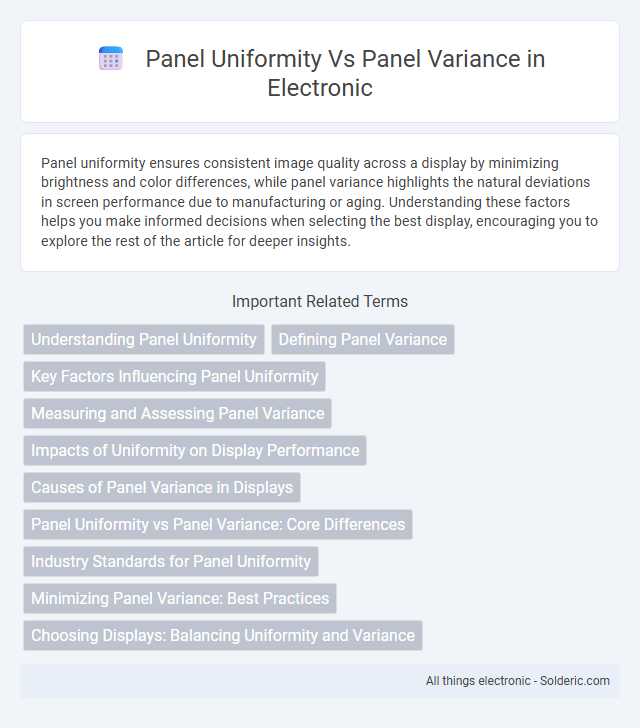Panel uniformity ensures consistent image quality across a display by minimizing brightness and color differences, while panel variance highlights the natural deviations in screen performance due to manufacturing or aging. Understanding these factors helps you make informed decisions when selecting the best display, encouraging you to explore the rest of the article for deeper insights.
Comparison Table
| Aspect | Panel Uniformity | Panel Variance |
|---|---|---|
| Definition | Consistency of display characteristics across the entire screen | Measure of variation or deviation in panel quality or performance |
| Focus | Even color, brightness, and luminance distribution | Differences in pixel behavior, color accuracy, and brightness |
| Importance | Critical for high-quality visual experience and professional use | Indicates manufacturing inconsistencies affecting display performance |
| Measurement | Percentage or score indicating uniformity across the panel | Statistical variance metrics showing deviation levels |
| Impact | Enhances visual coherence and reduces eye strain | Leads to color shifts, uneven brightness, and reduced image quality |
| Application | Monitors, TVs, smartphones for consistent display output | Quality control, panel selection, and performance benchmarking |
Understanding Panel Uniformity
Panel uniformity refers to the consistent brightness and color reproduction across the entire display surface, ensuring an even visual experience without noticeable patches or color shifts. High uniformity is crucial for professional monitor calibration, medical imaging, and graphic design, where precise color accuracy is mandatory. Manufacturers often measure panel uniformity using luminance and chromaticity variation metrics to guarantee minimal deviation and optimal display performance.
Defining Panel Variance
Panel variance refers to the degree of variation in brightness or color across different areas of a display panel, indicating inconsistencies that can affect image quality. High panel variance results in noticeable discrepancies in luminance or hue, leading to uneven visual experiences. Understanding panel variance helps optimize your device's display for uniformity and accurate color representation.
Key Factors Influencing Panel Uniformity
Key factors influencing panel uniformity include the quality of backlighting, the consistency of liquid crystal alignment, and the precision of manufacturing processes. Variations in temperature and external pressure can also affect uniformity, causing noticeable differences in color and brightness across the display. Ensuring these elements are controlled helps maintain your screen's visual consistency and overall image quality.
Measuring and Assessing Panel Variance
Measuring panel variance involves analyzing the consistency of luminance and color across different sections of a display panel to ensure uniform image quality. Assessment techniques include using luminance meters and colorimeters to detect deviations in brightness and color accuracy, which directly affect the visual experience. Quantifying variance through metrics like delta E and luminance uniformity percentage helps identify areas of improvement for display calibration and manufacturing processes.
Impacts of Uniformity on Display Performance
Panel uniformity directly affects the consistency of brightness and color across your display, ensuring a more immersive and visually accurate experience. Higher uniformity reduces issues such as color shifting, brightness hotspots, and dark corners, enhancing overall image quality and reducing eye strain. Improved uniformity also benefits professional applications like photo editing and video production by maintaining precise color representation and contrast.
Causes of Panel Variance in Displays
Panel variance in displays is primarily caused by differences in manufacturing processes, variations in material quality, and inconsistencies in calibration. Factors such as pixel aging, uneven backlighting, and temperature fluctuations also contribute to noticeable discrepancies between panels. Understanding these causes helps you anticipate variations and optimize display performance.
Panel Uniformity vs Panel Variance: Core Differences
Panel uniformity measures the consistency of brightness and color across the entire display surface, ensuring a balanced and even viewing experience. Panel variance quantifies the degree of deviation in luminance and chromaticity between different areas, indicating potential disparities or anomalies. Understanding the core differences between panel uniformity and variance is crucial for assessing display quality and detecting manufacturing defects.
Industry Standards for Panel Uniformity
Industry standards for panel uniformity prioritize consistent luminance and color accuracy across the entire display to ensure optimal visual performance. Specifications such as Delta E values below 3 and brightness uniformity within +-10% are commonly required in professional-grade monitors for medical imaging, graphic design, and broadcast production. Compliance with standards like ISO 9241-307 and guidelines from the Video Electronics Standards Association (VESA) guarantees minimal panel variance, enhancing overall image quality and user experience.
Minimizing Panel Variance: Best Practices
Minimizing panel variance ensures consistent luminance and color accuracy across your display, significantly enhancing visual performance and reducing eye strain. Best practices include calibrating each panel with advanced color mapping technologies, using uniform backlighting, and implementing regular quality control checks to detect deviations early. Applying these methods maintains uniformity, improving your viewing experience and content precision.
Choosing Displays: Balancing Uniformity and Variance
Choosing displays requires balancing panel uniformity, which ensures consistent color and brightness across the screen, against panel variance, which can introduce noticeable differences in image quality. High uniformity is critical for professional applications like photo editing and medical imaging where precision matters. In contrast, some variance might be acceptable or even desirable in casual use or gaming, where a broader range of colors and dynamic contrast enhance visual experience.
Panel Uniformity vs Panel Variance Infographic

 solderic.com
solderic.com